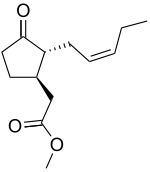Methyl jasmonate
Methyl jasmonate (abbreviated MeJA) is a volatile organic compound used in plant defense and many diverse developmental pathways such as seed germination, root growth, flowering, fruit ripening, and senescence.[1] Methyl jasmonate is derived from jasmonic acid and the reaction is catalyzed by S-adenosyl-L-methionine:jasmonic acid carboxyl methyltransferase.[2]
 | |
| Names | |
|---|---|
| IUPAC name
Methyl (1R,2R)-3-Oxo-2-(2Z)-2- | |
| Other names
Methyl jasmonate | |
| Identifiers | |
3D model (JSmol) |
|
| ChEBI | |
| ChemSpider | |
| ECHA InfoCard | 100.013.562 |
| EC Number |
|
| KEGG | |
PubChem CID |
|
| UNII | |
CompTox Dashboard (EPA) |
|
| |
| |
| Properties | |
| C13H20O3 | |
| Molar mass | 224.3 g/mol |
| Appearance | Colorless liquid |
| Melting point | < 25 °C (77 °F; 298 K) |
| Boiling point | 88 to 90 °C (190 to 194 °F; 361 to 363 K) at 0.1 mmHg |
Except where otherwise noted, data are given for materials in their standard state (at 25 °C [77 °F], 100 kPa). | |
| Infobox references | |
Description
Plants produce jasmonic acid and methyl jasmonate in response to many biotic and abiotic stresses (in particular, herbivory and wounding), which build up in the damaged parts of the plant. The methyl jasmonate can be used to signal the original plant’s defense systems or it can be spread by physical contact or through the air to produce a defensive reaction in unharmed plants. The unharmed plants absorb the airborne MeJA through either the stomata or diffusion through the leaf cell cytoplasm. An herbivorous attack on a plant causes it to produce MeJA both for internal defense and for a signaling compound to other plants.[3]
Defense chemicals
MeJA can induce the plant to produce multiple different types of defense chemicals such as phytoalexins (antimicrobial),[4] nicotine or protease inhibitors.[3] The protease inhibitors interfere with the insect digestive process and discourage the insect from eating the plant again.
MeJA has been used to stimulate traumatic resin duct production in Norway spruce trees.[5] This can be used as a defense against many insect attackers as a type of vaccine.
Experiments
In recent experiments, Methyl jasmonate has been shown to be effective at preventing bacterial growth in plants when applied in a spray to the leaves. The antibacterial effect is thought to be because of methyl jasmonate inducing resistance. [6]
MeJA is also a plant hormone involved in tendril (root) coiling, flowering, seed and fruit maturation. An increase of the hormone affects flowering time, flower morphology and the number of open flowers.[7] MeJA induces ethylene-forming enzyme activity, which increases the amount of ethylene to the amount necessary for fruit maturation.[8]
Increased amounts of methyl jasmonate in plant roots have shown to inhibit their growth.[9] It is predicted that the higher amounts of MeJA activate previously unexpressed genes within the roots to cause the growth inhibition.[8]
Cancer cells
Methyl jasmonate induces cytochrome C release in the mitochondria of cancer cells, leading to cell death, but does not harm normal cells. To be specific, it can cause cell death in B-cell chronic lymphocytic leukemia cells taken from human patients with this disease and then treated in tissue culture with methyl jasmonate. Treatment of isolated normal human blood lymphocytes did not result in cell death [10]
See also
References
- Cheong, Jong-Joo; Choi, Yang Do (July 2003). "Methyl jasmonate as a vital substance in plants". Trends in Genetics. 19 (7): 409–413. doi:10.1016/S0168-9525(03)00138-0. PMID 12850447.
- Christie, William W. Plant oxylipins: Chemistry and biology, 22 May 2014. Archived from the original on 2015-06-30. Retrieved on 2017-07-11.
- Farmer, E. E.; Ryan, C. A. (1 October 1990). "Interplant communication: airborne methyl jasmonate induces synthesis of proteinase inhibitors in plant leaves". Proceedings of the National Academy of Sciences. 87 (19): 7713–7716. doi:10.1073/pnas.87.19.7713. PMC 54818. PMID 11607107.
- Stanley, D. Keeping Freshness in Fresh-Cut Produce, Agricultural Research Magazine, United States Department of Agriculture, Feb. 1998. Retrieved on 2010-10-27.
- Martin, D.M., Gershenzon J. and Bohlmann J. Induction of Volatile Terpene Biosynthesis and Diurnal Emission by Methyl Jasmonate in Foliage of Norway Spruce, Plant Physiology, 2003. Retrieved on 2016-09-01.
- Luzzatto, T., Yishay, M., Lipsky, A., Ion, A., Belausov, E. and Yedidia, I. Efficient, long-lasting resistance against the soft rot bacterium Pectobacterium carotovorum in calla lily provided by the plant activator methyl jasmonate. Plant Pathology, 56(4):692-701, Aug 2007. doi:10.1111/j.1365-3059.2007.01622.x. Retrieved 2017-07-11.
- Radhika, V., J. Cost, W. Boland, and M. Heil. The role of jasmonates in floral nectar secretion. PLOS ONE. 2010. doi:10.1371/journal.pone.0009265 Retrieved on 2010-10-27.
- Berger, S.; Bell, E.; Mullet, J. E. (1 June 1996). "Two Methyl Jasmonate-Insensitive Mutants Show Altered Expression of AtVsp in Response to Methyl Jasmonate and Wounding". Plant Physiology. 111 (2): 525–531. doi:10.1104/pp.111.2.525. PMC 157863. PMID 12226307.
- Wasternack, C. Jasmonates: An Update on Biosynthesis, Signal Transduction and Action in Plant Stress Response, Growth and Development. Annals of Botany (2007) 100(4):681-697. doi:10.1093/aob/mcm079. Retrieved on 2010-10-27.
- Rotem, R., A. Heyfets, O. Fingrut, D. Blickstein, M. Shaklai, and E. Flesher. 2005. Jasmonates: novel anticancer agents acting directly and selectively on human cancer cell mitochondria. Cancer Research 65(5):1984-1993. doi:10.1158/0008-5472.CAN-04-3091. Retrieved on 2010-10-27.
External links
- General information about methyl jasmonate
- Jasmonate: pharmaceutical composition for treatment of cancer. US Patent Issued on October 22, 2002
- Plant stress hormones suppress the proliferation and induce apoptosis in human cancer cells, Leukemia, Nature, April 2002, Volume 16, Number 4, Pages 608-616
- Jasmonates induce nonapoptotic death in high-resistance mutant p53-expressing B-lymphoma cells, British Journal of Pharmacology (2005) 146, 800–808. doi:10.1038/sj.bjp.0706394; published online 19 September 2005